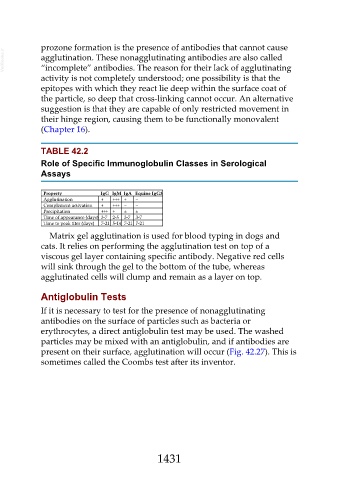Page 1431 - Veterinary Immunology, 10th Edition
P. 1431
prozone formation is the presence of antibodies that cannot cause
VetBooks.ir agglutination. These nonagglutinating antibodies are also called
“incomplete” antibodies. The reason for their lack of agglutinating
activity is not completely understood; one possibility is that the
epitopes with which they react lie deep within the surface coat of
the particle, so deep that cross-linking cannot occur. An alternative
suggestion is that they are capable of only restricted movement in
their hinge region, causing them to be functionally monovalent
(Chapter 16).
TABLE 42.2
Role of Specific Immunoglobulin Classes in Serological
Assays
Property IgG IgM IgA Equine IgG3
Agglutination + +++ + –
Complement activation + +++ – –
Precipitation +++ + ± ±
Time of appearance (days) 3-7 2-5 3-7 3-7
Time to peak titer (days) 7-21 5-14 7-21 7-21
Matrix gel agglutination is used for blood typing in dogs and
cats. It relies on performing the agglutination test on top of a
viscous gel layer containing specific antibody. Negative red cells
will sink through the gel to the bottom of the tube, whereas
agglutinated cells will clump and remain as a layer on top.
Antiglobulin Tests
If it is necessary to test for the presence of nonagglutinating
antibodies on the surface of particles such as bacteria or
erythrocytes, a direct antiglobulin test may be used. The washed
particles may be mixed with an antiglobulin, and if antibodies are
present on their surface, agglutination will occur (Fig. 42.27). This is
sometimes called the Coombs test after its inventor.
1431

